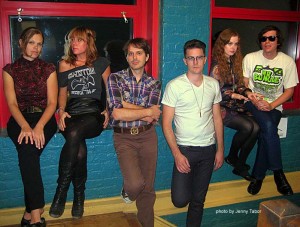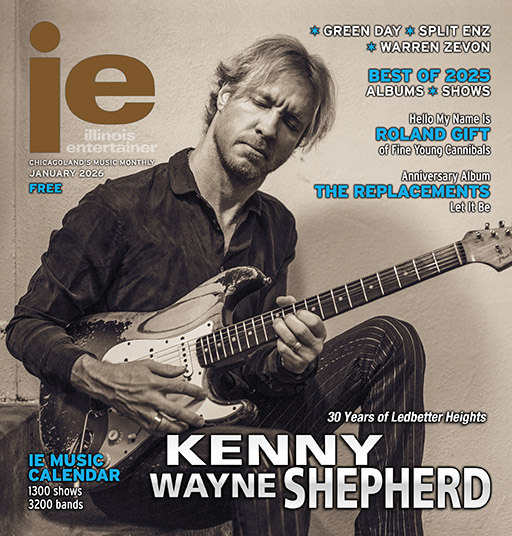Interview: The 1900s
The Dawn Of A Century

Don’t call The 1900s deserters. The band might have wasted a bundle of positive media buzz and eager fans gained from its promising 2007 debut, Cold & Kind, on two years of near-seclusion (the group did grace a handful of Chicago summer festivals and lent its talents to a benefit night in support of the Scotland Yard Gospel Choir), but interpersonal squabbles and an obsessive attention to detail threatened to derail the whole operation.
Appearing: Friday, December 3rd at Empty Bottle in Chicago.
“We did kind of fall off the map a little, I guess,” guitarist and primary songwriter Edward Anderson explains over a beer at Bucktown mainstay Quenchers Saloon. “Everyone thought we broke up.”
Instead of the entire group completely unraveling, the bitter departure of two founding members (multi-instrumentalist Mike Jasinksi and drummer Tim Minnick) paved the way for a rebirth that finds the remaining members (singers Jeanine O’Toole and Caroline Donovan, bassist Charlie Ransford, violinist Andra Kulans) taking on new roles left vacant and welcoming drummer Matt Roan into the fold.
“There was a brief moment where we were like, ‘What are we gonna do?’ But, I think we’ve always, in the face of adversity, we’d always be like, ‘Fuck it. We’re not going to cave into it, we’re gonna do whatever it takes.’ There was like a good bonding from everyone who stuck with it. There was never a doubt that we were going to keep doing it, especially because we had these new songs that we wanted to start working on. I don’t think there was a doubt that we were planning to continue in some shape or form,” Anderson recounts. “I think the identity of the band is more on where the singers are. I think if we lost Jeanine or Caroline, I think that would be a real difference, but as long as we have our harmonies . . .”
Now that harmonious working conditions make up the norm, Anderson can look back on this tumultuous period in the band’s history without reservation.
“It was a really hard time for us all. Some people just bring out the worst in everybody and it got really stressful and everyone was fighting,” Anderson remembers. “It was almost like we were restarting in a way, starting from phase one again. In my mind it was kind of the beginning of that cycle again where we get everything reorganized, in a way reinvent ourselves. But, we kind of went into the cocoon and came back out.”
The coming out party can be traced back to November with the release of the band’s sophomore effort, Return Of The Century (Parasol). Mostly recorded in the apartment Anderson and Donovan share, the album simultaneously suffered and benefited from its proximity to Anderson’s twiddling thumbs. Unlike the Cold & Kind sessions, which started with the whole band sitting in a room together fleshing out songs and arranging parts and then hiring folks to compose elaborate string arrangements, this record took shape in a piecemeal fashion with various members coming in one-by-one to record their parts and make their mark.
“In a way, people’s individual ideas came into play more,” Anderson says of the process. “Their individual talents and idiosyncrasies are shining a little bit more on this record because they had time, like unadulterated time to just sit down and create whatever they wanted to.”
This unfettered access had both pros and cons. On the positive side, “Having done a lot of it at home gave us the freedom to just relax and capture the kind of performance that we wanted to and also to be free to spend more time just experimenting with different things,” Anderson explains. “Last time, we recorded the vocals in the studio and it could be kind of a sterile situation sometimes, but a lot of the time I would just record my vocals at my studio at like 2 or 3 in the morning. If the inspiration struck I would just be able to do it and if I didn’t like it, I could just do it again and not worry about paying a ton of money to have someone record it for me.”
On the negative side, the album almost drove Anderson to the brink. Over the course of a year and a half, he was constantly reconfiguring Century‘s 11-song sequence. Listening to early demos, Anderson can hardly recognize those early renditions when compared to the final product – and it didn’t stop at the recording. “Even once we were done recording we would mix the songs three or four times, just completely different mixes of the songs. We’re really kind of perfectionists, obsessive, just going crazy over every littlest detail,” he remembers.
In addition to agonizing over even the most arbitrary guitar part, Anderson made the tunes follow an all-encompassing story arc revolving around a feminine journey (to better showcase the ethereal vocals of both O’Toole and Donovan). He’s lucky he didn’t end up like his inspiration: Scottish folk singer Licorice McKechnie of the Incredible String Band, who traveled to Arizona, got mixed up in a new age cult, and disappeared.
“I was always really intrigued by that story, I kind of used that as a jumping off point to explore the idea of trying to run away from your past and really jump headfirst into a kind of new world and how you deal with your memories of your past life and how that baggage stays with you and what happens when you’re in these crazy new places and you are losing your mind and you are just losing yourself in this magical realm,” Anderson untangles.
“At the end of the record, this female character returns back home and . . . she kind of tells her whole story at the end of [‘Jean Demon’] and reflecting on her experience. The album starts like, ‘You want to run so free, why would you be running from me,’ and that’s me talking to her, so it’s kind of like a dialogue going back and forth. At the end she comes back, but she’s a very different, changed person. So that’s the arc of the story, I guess. It’s pretty intense.”
Whether consumed as a whole or on shuffle mode, one thing remains clear – Anderson succeeded in his goal of putting the girls front and center. “Tuscon” reverberates hymn-like with O’Toole’s crystalline voice while Donovan lights up the spunky “Lions Fur.”
In a strange anomaly for an audiophile like Anderson, he prefers listening to the sweet intermingling of their voices through the small speakers of a laptop. In fact, he mixed the album with that in mind.
“It’s like the modern day AM. The frequency spectrum is so tiny, that in a certain way it really focuses on the most basic core elements of the song,” he explains.
And when you have the core elements of your band intact, it’s that much easier.
— Janine Schaults











